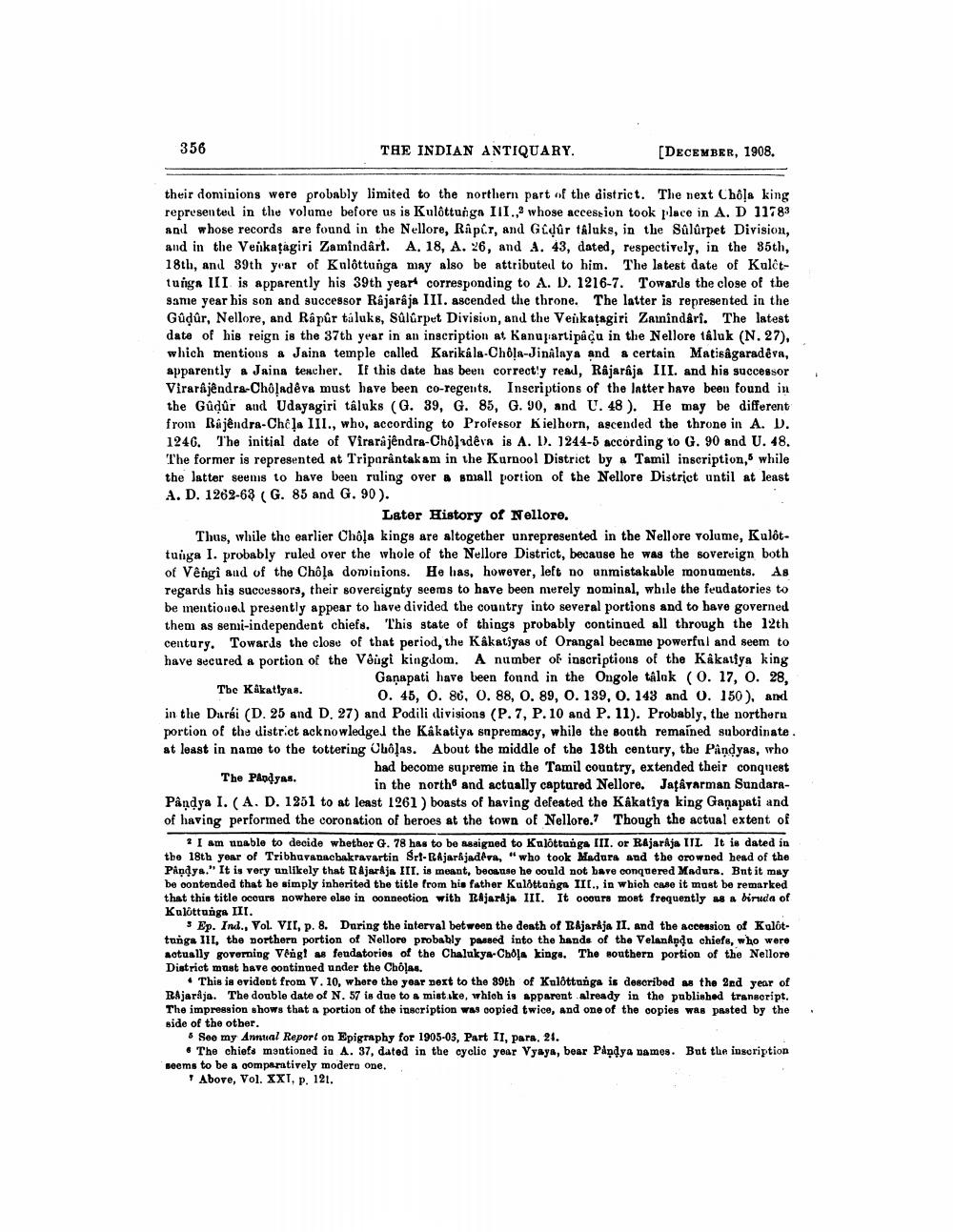________________
356
THE INDIAN ANTIQUARY.
[DECEMBER, 1908.
their dominions were probably limited to the northern part of the district. The next Chôla king represented in the volume before us is Kulôttunga III., whose accession took place in A. D 11783 and whose records are found in the Nellore, Râpir, and Gudûr tâluks, in the Sûlûrpet Division, and in the Venkatagiri Zamindârf. A. 18, A. 26, and A. 43, dated, respectively, in the 85th, 18th, and 39th year of Kulôttunga may also be attributed to him. The latest date of Kulêttunga III is apparently his 39th year corresponding to A. D. 1216-7. Towards the close of the same year his son and successor Râjarâja III. ascended the throne. The latter is represented in the Gûdûr, Nellore, and Râpûr taluks, Sûlûrpet Division, and the Venkatagiri Zamindârî. The latest date of his reign is the 37th year in an inscription at Kanupartipâçu in the Nellore taluk (N. 27), which mentions a Jaina temple called Karikála-Chôla-Jinalaya and a certain Matisâgaradêva, apparently a Jaina teacher. If this date has been correctly read, Rajaraja III. and his successor Virarajendra-Chôladêva must have been co-regents. Inscriptions of the latter have been found in the Gûdûr and Udayagiri tâluks (G. 39, G. 85, G. 90, and U. 48). He may be different from Rajendra-Chĉ la III., who, according to Professor Kielhorn, ascended the throne in A. D. 1246. The initial date of Virarajêndra-Chôladêva is A. 1). 1244-5 according to G. 90 and U. 48. The former is represented at Triparântakam in the Kurnool District by a Tamil inscription, while the latter seems to have been ruling over a small portion of the Nellore District until at least A. D. 1262-63 (G. 85 and G. 90).
Later History of Nellore.
Thus, while the earlier Chôla kings are altogether unrepresented in the Nellore volume, Kulôttunga I. probably ruled over the whole of the Nellore District, because he was the sovereign both of Vêngi and of the Chôla dominions. He has, however, left no unmistakable monuments. As regards his successors, their sovereignty seems to have been merely nominal, while the feudatories to be mentioned presently appear to have divided the country into several portions and to have governed them as semi-independent chiefs. This state of things probably continued all through the 12th century. Towards the close of that period, the Kakatiyas of Orangal became powerful and seem to have secured a portion of the Vêugi kingdom. A number of inscriptions of the Kakatiya king Ganapati have been found in the Ongole tálak (0. 17, 0. 28, 0. 45, 0. 86, O. 88, O. 89, O. 139, O. 143 and 0. 150), and in the Darsi (D. 25 and D. 27) and Podili divisions (P. 7, P. 10 and P. 11). Probably, the northern portion of the district acknowledged the Kakatiya supremacy, while the south remained subordinate. at least in name to the tottering Cholas. About the middle of the 18th century, the Pandyas, who had become supreme in the Tamil country, extended their conquest The Pandyas. in the north and actually captured Nellore. Jațâvarman SundaraPandya I. (A. D. 1251 to at least 1261) boasts of having defeated the Kakatiya king Ganapati and of having performed the coronation of heroes at the town of Nellore. Though the actual extent of
The Kakatiyas.
2 I am unable to decide whether G. 78 has to be assigned to Kulôttunga III. or Rajaraja III. It is dated in the 18th year of Tribhuvanachakravartin Srt-Rajarajadera, "who took Madura and the crowned head of the Pandya." It is very unlikely that Rajaraja III. is meant, because he could not have conquered Madura. But it may be contended that he simply inherited the title from his father Kulôttanga III., in which case it must be remarked that this title occurs nowhere else in connection with Rajaraja III. It occurs most frequently as a biruda of Kulottunga III.
3 Ep. Ind., Vol. VII, p. 8. During the interval between the death of Rajaraja II. and the accession of Kulottunga III, the northern portion of Nellore probably passed into the hands of the Velanandu chiefs, who were actually governing Vêng! as feudatories of the Chalukya-Chola kings. The southern portion of the Nellore District must have continued under the Chōlas.
This is evident from V. 10, where the year next to the 39th of Kulôttunga is described as the 2nd year of Rajaraja. The double date of N. 57 is due to a mistake, which is apparent already in the published transcript. The impression shows that a portion of the inscription was copied twice, and one of the copies was pasted by the side of the other.
5 See my Annual Report on Epigraphy for 1905-03, Part II, para. 21.
The chiefs mentioned in A. 37, dated in the cyclic year Vyaya, bear Pandya names. But the inscription seems to be a comparatively modern one.
Above, Vol. XXI, p. 121.




